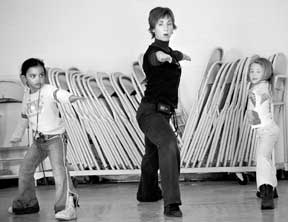                                                |
|
 |
|
Mills Lawn first-grade students
Rachele Orme, left, and Lindsey Ward warming up earlier this month
for dance class with resident dancer Margot Greenlee.
|
Artists-in-residence
at Mills Lawn—
Explore
under the surface
Dorothy Poortinga’s second graders know what they are getting from
dancing with Margot Greenlee, one of the resident artists at Mills Lawn
School this month.
Emma Peifer likes it because she gets to have someone copy her in the
mirroring exercise.
Aidan Ceney never knew he could spin so well.
Cheyenne Stilabower learned through trusting her body in dance that she
didn’t have to be afraid of sledding down the Gaunt Park hill anymore.
“You just close your eyes and do it!” she said.
The process of learning trust and expression through dance and theater
may not always be obvious in the performance. Greenlee, from the Liz Lerman
Dance Exchange, and artists-in-residence Jeff Hooper and Hal Walker, from
Mad River Theater Works, have spent three weeks finding experiential ways
for students in kindergarten through grade four to develop an intimacy
with the theme of diversity as part of the school’s “Looking
In, Looking Out” project.
The students performed “Underneath the Surface” last Friday
at Fairborn High School. The performance offered a view of the greater
process the students went through together to get there.
Greenlee began a Tuesday morning dance class with a question: “What
accumulated two inches this morning?”
“Snow!” several second graders yelled out.
The question opened the brainstorming discussion about the different ways
people around the world predict the weather, what kinds of things happen
when it snows and what happens after it snows that connects everyone around
the world.
The students came up with movements to express a snowy blizzard by whisking
around the room, arms sailing above their heads. Then they practiced sliding
their feet along the floor as though they were skating on ice. Next they
imitated the snow melting and evaporating by swishing around like the
wind and drawing their fingers up from the floor like water molecules
going up into the air.
In 15 minutes the students had choreographed a stylish dance with a beginning,
a middle and an end, smiling right through the angst and grit of creating
a work of art. The dance may or may not enter into the performance, but
it will live in the memory of the body as a step toward better artistic
expression.
“The idea is that we’ll make four times as much as we’ll
use,” Greenlee said. “You try to be ready for the changes that
come and help make those changes.”
Spontaneity and improvisation are like second nature to artists in the
theater. But theater residents Hooper and Walker take a different approach
to getting students to express themselves and their stories.
“I tend to be more story oriented, and Margot is more physical property
oriented,” Hooper said.
The stories the third- and fourth-grade students adapted to the stage
were taken from interviews they did with community reading tutors. The
students created several unscripted playlets based on the experiences
of their elders. Hooper wanted to focus on getting students to understand
the character and the emotion they were trying to portray rather than
having them memorize a script.
“This is a great age to work with because they’re old enough
to grasp the idea of imagining the circumstances they’ll be in on
stage,” Hooper said. “But they’re not so old that they
have a lot of inhibitions, and they’re not afraid to be silly and
get out there and try new things.”
On Tuesday the third graders were trying to stay in their characters as
they rehearsed the scenarios they had created. Walker told them that even
if their words changed a little each time they rehearsed it, their enthusiasm
and stress on particular emotions were the important things to focus on.
The theater team also found that the learning process wouldn’t necessarily
parallel the performance at the end of the program.
“The challenge is finding the balance between product and process,”
Walker said.
The experience of a performance has value in and of itself, but the road
to get there could be more lasting.
“Sometimes I look at these kids and think, how powerful are you going
to be as an adult,” Greenlee said. “These kids will be inventive
thinkers and strong arts advocates.”
—Lauren
Heaton
|



